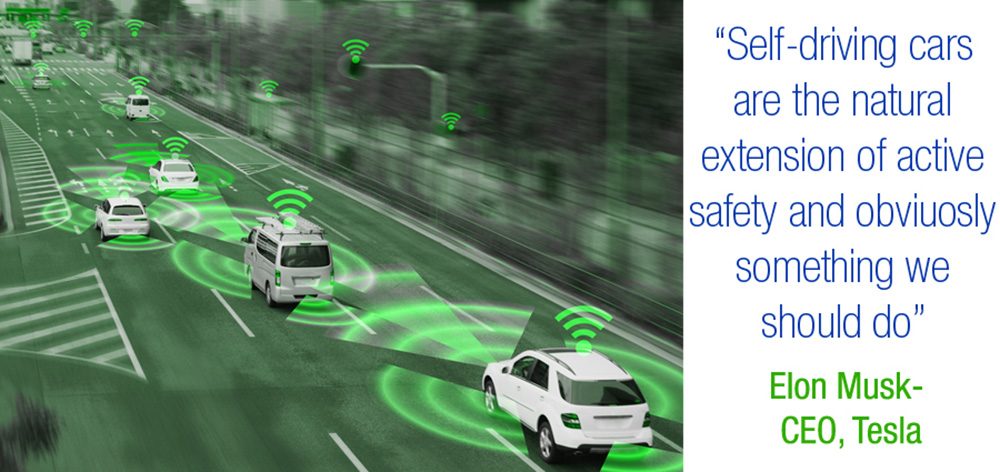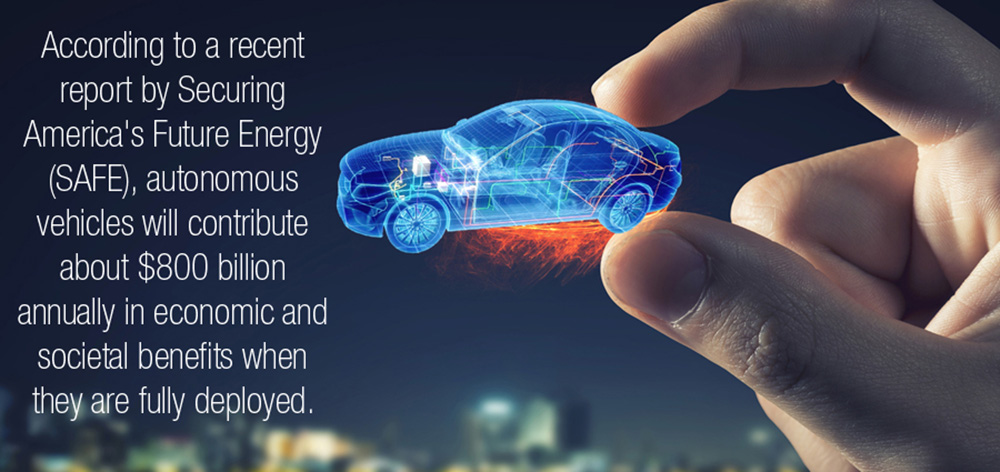Right from the first time when vehicles where first produced, someone has always been behind the wheels, monitoring and controlling its operations. However, this phenomenon is set to change with the advancements in Autonomous Driving.
Also known as Automation Driving Systems (ADS), this technological evolution is expected to revolutionize transportation (by extension, businesses and societies), thereby creating a paradigm shift in term of consumer experience, mode choices and business preferences. The last decade has seen remarkable progress in ADS technology, as automobile companies continue to integrate elements of auto-piloting into vehicle operations. The present status of ADS signifies continuous advancements and variation in ADS systems in the foreseeable future. By the end of this decade, ADS vehicles are expected to become commercially available.
What is Autonomous Driving: Where are We Now and What Does the Future Look Like?
Autonomous Driving goes by many names, Automated Driving System, Autonomous Vehicle, and so on. They all imply the substitution of human driving for machine. Sources define Autonomous Vehicles as cars or trucks capable of sensing the environment and functioning without human involvements or inputs. AV does not require the presence of a human passenger to take control of its operations at any time; rather, it works using a combination of sensors, actuators and complex software, to control, navigate and drive.
According to the Society of Automotive Engineers (SAE), Autonomous Driving has 6 phases or levels, each level varying in functionality. Here are the levels as adopted by the US Department of Transportation.
- Level 0: No Automation: Fully manual, the human passenger performs all driving task, although vehicles might consist of features like automatic emergency braking as so on.
- Level 1: Driver Assistance: Vehicle possesses a singular automated system while drivers control navigation.
- Level 2: Partial Automation: Vehicles can carry out steering and acceleration tasks. Drivers still monitor operations and can take control at any time
- Level 3: Conditional Automation: Environmental monitoring and navigation capabilities. Vehicles can perform almost all driving tasks is criteria are met, however, human override is still needed.
- Level 4: High Automation: Here, the vehicle can execute all driving operations and doesn’t require drivers to take over navigation. However, automated features are conditional and human intervention is optional.
- Level 5 – Full Automation: Zero human input is required as vehicles can perform all driving functions in all conditions.

At present, the world isn’t yet at level 5 yet, but optimists and most auto manufacturers are hopeful for its implementation soon. In fact, Elon Musk, founder of Telsa, disclosed intentions of making fully automated electric vehicles available by 2020. Regulations and guidelines have also been put in place in preparation of the influx of self-driving vehicles by the Federal Automated Vehicle Policy and the Centre For Internet and Society.
At present, there are no legal completely automated cars in the USA; the latest car models consist of level 2 and level 3 features, with different amounts of self-automated functionalities.
Brands such as BMW have introduced traffic jam assists and automated parking systems in their new products. Other semi-automated features of newer cars include intelligent drive, super cruise, multiple lane control or lane correction, potential collision detection and much more. Despite the significant progress currently experienced with Automated Vehicles, there are still divergent perspectives on its projections. While Ford, Hyundai, Kia, Toyota and other manufacturers intend to release fully automated, level 5 vehicles to the market by 2020-2021, others are of the view that self-driving vehicles are not feasible in the next five years.
A recent McKinsey & Company study revealed that autonomous vehicles and advanced driver assistance systems could reduce motor vehicle deaths by 90 percent, saving thousands of lives and roughly $190 billion annually in health care costs. Improved vehicle safety will also boost business operations and save costs by significantly lowering the number of goods damaged due to road accidents and ensuring quicker delivery of products and services. Roads filled with automated vehicles will ensure smooth traffic flow and reduce traffic congestion, thereby saving commuters’ time and money.
Impacts on Businesses
Intelligent, self-automated vehicles have wide-ranging benefits to the business sector, especially to industries that require autonomous fleet for operations. Farming and mining industries which fall under this category, are rapidly adopting the technology because it is safer, as it has the potential of minimalizing work accidents and cost-effective. AVs can also create a variety of opportunities for retail, healthcare, and entertainment industries if they proliferate as anticipated.
According to the US Census Bureau, an average American spent up to 29.5 billion hours in transit in 2014. With automated driving, the time is expected to reduce drastically, thereby creating a lot more time for other activities such as shopping online, consuming movies or music content, or buying food and beverages.
In 2018, China’s e-commerce giant Alibaba began using driverless robots, G Plus, to deliver online orders to secured e-lockers. The following year, the German automotive manufacturing company, Continental AG, announced a new solution to autonomously deliver packages to customers’ doorsteps: robot delivery ‘dogs.’ Automobile manufacturer, Ford estimates that A.V.s will reduce delivery cost per mile from $2.5 to $1 as more and more retailers strive to apply autonomous technology in all their logistics processes.
This shift can catapult e-commerce, retail food vendors, and entertainment businesses to the next level. The importance of AVs in the industry also includes reduced cost of human labor and increased safety of employees in high-risk environments.
Impacts of Workforce
Studies have revealed that by 2035, an estimated 12 million fully automated and 18 million partially automated vehicles are expected to be sold annually across the globe. The implications of this are mass unemployment, particularly for drivers.
In the US, states like Mississippi, Wyoming, North Dakota, Virginia, and Idaho who have a large percentage of drivers will be severely affected. Also, minority races such as Blacks, Hispanic and Native Americans will be hit hard. There are also predictions that the auto manufacturing industry will rapidly decline, leading to the loss of millions of jobs.
Experts explain that this decline will be as a result of lesser needs for car ownership as more people opt for automated vehicles. On the brighter side, AVs can increase the productivity of workers and reduce the stress of commuting, by eliminating traffic jams and creating more time to work while commuting.
Experts believe that the A.V. industry will create more jobs; especially as multiple companies race to put the first self-driving car into action. Investments plunged into the development and improvement of A.V. technology are massive and expected to grow in the not-to-distant future. Ford recently announced that its plans to spend $4 billion on autonomous vehicles by 2023. G.M. intends to pour $100 million into self-driving cars, and Toyota launched a $2.8 billion self-driving car company in Tokyo. To achieve and maintain fully automated systems, these companies will need engineers, technicians, software developers, and designers, increasing the demand for these workers.

Impacts on Societies
The greatest impact of Autonomous vehicles is an enhanced quality of life for individuals in society. The journey to improved welfare via AVs begins with safeguarding lives on roads.
Reports from BCG suggest that AVs will eliminate traffic fatalities and drastically reduce collisions in all types of travel. Other numerous sources also outline the potential of AVs in averting 90% of auto accidents and reducing health costs and damages.
With AVs, there will also be a significant reduction of carbon emissions as well as congestion, due to the lesser amount of vehicles that will ply the roads. Accessibility to cars and various destinations by the aged, physically challenged, and people with other mobility issues is another anticipated advantage of AVs. As for hospitality, AVs will provide more space for outdoor events and encourage frequent trips across cities.
The actualization of autonomous driving will also lead to an economic boom, especially in the U.S. According to a recent report by Securing America’s Future Energy (SAFE), autonomous vehicles will contribute about $800 billion annually in economic and societal benefits when they are fully deployed. The report predicts that these benefits will come from cost savings related to reduced crashes, fuel efficiency, and better access to transportation.

Conclusion
Autonomous vehicles are poised to radically alter businesses, the economy, and society in general. These expected impacts have raised some concerns such as the ethicality of self-governing machines, the safety of passengers, the future of the unemployed, regulation and the right software, hardware package, and system right for autonomous vehicles. To overcome these challenges, tech companies, automakers, and the government must work closely together. This collaboration will help tackle these problems and facilitate the implementation of policies and regulations that will benefit the transportation industry and the public.
About the author
Dr. Srikanth Gaddam is an author, angel investor, and a seasoned entrepreneur who launched three successful technology companies in the last seventeen years. Dr. Gaddam’ s greatest accomplishment lies in raising ERP Analysts, Inc. from a two-person organization to an eighty-five-million-dollar firm. ERP Analysts, Inc. has been recognized as one of the fastest-growing companies by Inc. 5000 for ten years, Deloitte Fast 500, & Business First Fast 50 for several years. ERP Analysts is recognized as a “Best Places to Work” in Ohio for several years (www.erpagroup.com). Dr. Gaddam graduated from the Doctor of Management (DM) from Case Western Reserve University, MBA from the Ohio State University, and the Owner President Management program (OPM 43) from Harvard Business School. He is the author of the book “Destination Success: Discovering the Entrepreneurial Journey” and also co-author of “Roadmap to Success”.





